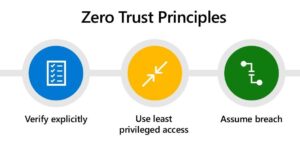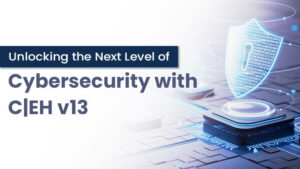Introduction
Zero Trust is a security framework that suggests no user or device should be trusted automatically, even if they are already inside the network perimeter. The Zero Trust model requires a comprehensive and continuous verification process before granting access to any resource or asset, regardless of location or origin.
The Zero Trust model is designed to prevent security breaches and limit the potential impact of any successful attacks. It recognizes that traditional security measures, such as firewalls and perimeter defenses, are insufficient to protect against modern threats, such as phishing attacks, insider threats, and Advanced Persistent Threats (APTs). Zero Trust is a proactive security approach that helps organizations better protect their critical assets and data from potential security breaches. This article covers detailed knowledge of the Core Principles of the Zero Trust Cybersecurity Model.
Working of Zero Trust
Here are the key components and working of Zero Trust:
- Identity Verification: All users, devices, and applications must be authenticated and authorized before accessing resources or data. This is typically done using Multi-Factor Authentication (MFA) and other identity verification methods.
- Network Segmentation: The network is divided into smaller segments or micro-perimeters, each with access controls and policies. This helps to contain any potential breaches and limit the spread of attacks.
- Access Control Policies: Access to resources and data is restricted based on the user’s role, device type, location, and other contextual factors. Access control policies are consistently enforced, and attempted violations are immediately flagged and logged.
- Continuous Monitoring: All network activity is monitored and analyzed for potential threats or anomalies. Any suspicious behavior or unusual activity is quickly detected and investigated.
- Risk-based Approach: Zero Trust uses a risk-based approach to security, which means that security controls are dynamically adjusted based on the perceived risk level of the user, device, or application. For example, a user logging in from a new device or location may be subject to additional verification steps and restrictions.
Overall, Zero Trust is a comprehensive security framework that provides a layered approach to security. It helps to protect against a wide range of modern threats, such as phishing attacks, insider threats, and Advanced Persistent Threats (APTs).
What are the Zero Trust Model’s Core Principles?
The three guiding principles of Zero Trust are as follows:
- Verify Explicitly – Consistently authenticate and authorize based on all accessible data points
- Least Privilege Access – Use Just-In-Time and Just-Enough-Access (JIT/JEA), risk-based adaptive policies, and data protection to restrict user access. This is known as least privilege access
- Assume breach – Reduce the explosion radius and segment access. To get visibility, drive threat detection, strengthen defenses, confirm end-to-end encryption, and leverage analytics
Zero Trust is founded on these guiding principles. The Zero Trust model validates each request as though it came from an unrestricted network rather than assuming that everything within the corporate firewall is secure. No matter from where a request comes or what resource it accesses, the Zero Trust paradigm instructs us to “never trust, always verify.”
The zero trust principles are graphically represented in the following diagram:

Technology Pillars
The entire digital estate should adopt a Zero Trust policy, which would act as an integrated security tenet and end-to-end plan. Implementing Zero Trust rules and technology across six core components achieves this. Each of these is a signal source, an enforcement control plane, and a vital resource that needs to be protected.
The Zero Trust strategy can be divided into the following major technology pillars:
- Zero Trust Identity Protection – The Zero Trust control plane is defined by identities, whether those identities represent individuals, services, or IoT devices. You need to verify identity with strong authentication whenever it tries to access a resource and make sure the access is appropriate and normal for that identity. Follow the least privilege access guidelines.
- Secure Endpoints with Zero Trust – After an identity has been given access to a resource, data can flow to several distinct endpoints, including IoT devices, smartphones, BYOD devices, partner-managed devices, and on-premises workloads housed on cloud servers. This kind expands the attack surface area significantly. Keep an eye on and enforce device compliance and health for secure access.
- Secure Applications with Zero Trust – APIs and applications offer the interface via which data is consumed. They could be modern SaaS applications or legacy on-premises workloads transferred to the cloud. Apply controls and technologies to find shadow IT, guarantee suitable in-app rights, gate access based on real-time analytics, watch for unusual activity, manage user actions, and evaluate secure configuration options.
- Secure Data with Zero Trust – In the end, security teams guard data. Data should, if possible, remain secure even after leaving the networks, devices, apps, infrastructure, and infrastructure the company controls. Encrypt, classify, and label data, then limit access based on those characteristics.
- Secure Infrastructure with Zero Trust – Infrastructure is a significant attack vector, whether in the form of on-premises servers, cloud-based VMS, containers, or micro-services. To strengthen the defense, evaluate version, configuration, and JIT access. Utilize telemetry to identify attacks and anomalies and automatically block, alert, and take preventive action against unsafe conduct.
- Secure Network with Zero Trust – All data is ultimately accessed through network infrastructure in secure networks with zero trust. Networking controls can offer crucial safeguards to improve visibility and aid in thwarting attackers’ lateral network movement. Segment networks (and perform further in-depth in-network micro-segmentation) and implement end-to-end encryption, monitoring, and analytics.
- Zero Trust Visibility, Automation, and Orchestration – Microsoft provides the technique for implementing an end-to-end Zero Trust methodology across identities, endpoints and devices, data, apps, infrastructure, and networks in our Zero Trust guidelines. These actions raise your profile, which provides you with better information for deciding who to trust. We require an integrated capability to manage the influx of data resulting from each of these discrete regions producing its own pertinent warnings to better fight against risks and validate trust in a transaction.
Zero Trust Use Cases
The Zero Trust model can be applied to various use cases across industries and organizations. Here are some common Zero Trust use cases:
- Remote Access: With the rise of remote work, many organizations use Zero Trust to secure remote access to their networks and applications. This includes using Multi-Factor Authentication (MFA), device profiling, and access control policies to verify the identity of remote users and restrict access to sensitive data and applications.
- Insider Threat Prevention: Zero Trust can be used to prevent insider threats by monitoring all network activity and restricting access to sensitive data and applications based on the user’s role and responsibilities. This includes using data analytics to detect any suspicious behavior or unusual activity and taking action to mitigate any potential threats.
- Supply Chain Security: The Zero Trust model can be used to secure supply chain networks and prevent unauthorized access to critical resources and data. This includes using access control policies, micro-segmentation, and data analytics to monitor all network activity and detect potential threats.
- Endpoint Security: Zero Trust can be used to secure endpoint devices such as laptops, smartphones, and tablets. This includes using device profiling, network segmentation, and access control policies to verify the identity of machines and restrict access to sensitive data and applications.
Zero Trust can be applied to a wide range of use cases and help organizations better protect their critical assets and data from potential security breaches.
Conclusion
The Zero Trust cybersecurity model is built on core principles that help organizations implement a proactive and comprehensive approach to security. These principles include verifying explicitly, least privilege access, assuming breach, micro-segmentation, continuous monitoring, and using data analytics. By adopting these principles, organizations can better protect their critical assets and data from many modern threats, such as phishing attacks, insider threats, and Advanced Persistent Threats (APTs).
The Zero Trust model provides a holistic and layered approach to security designed to prevent security breaches and minimize the impact of successful attacks.








